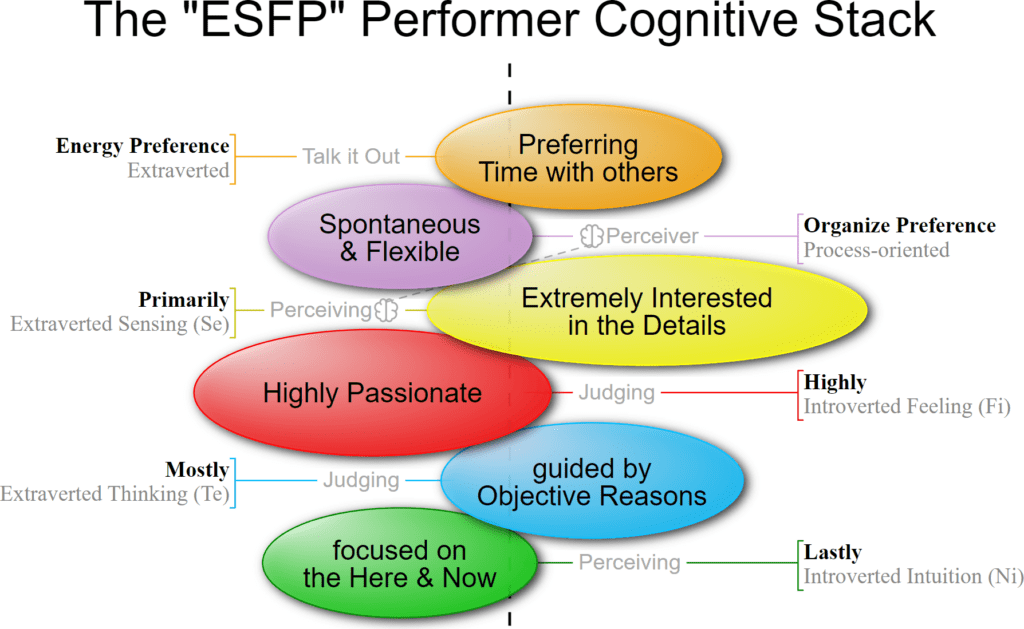What is the Keirsey ESFP “Performer” Personality Type?
The Keirsey ESFP “Performer” Personality Type is an Artisan Temperament with a Concrete Communication Style and a Utilitarian Action Style.
Keirsey organized the Four Temperaments as a matrix. There are two communication styles, abstract and Concrete, similar to the Myers-Briggs Intuition (Abstract) and Sensing (Concrete) “Perceiving” Cognitive Functions.
And by two action styles: cooperative and utilitarian. Utilitarian people, for the most part, do what works, while Cooperative people do what’s right.
Keirsey named the Four Temperaments as suggested by Plato: Artisan (Iconic), Guardian (Pistic), Idealist (Noetic), and Rational (Dianoetic).

Concrete versus Abstract Communication Style
Keirsey divided the Four Temperaments into two Communication Styles: Abstract and Concrete. These styles resemble the Myers-Briggs Intuition and Sensing “Perceiving” Cognitive Functions.
Some people talk primarily about everyday reality’s external, concrete world: facts and figures, work and play, home and family, news, sports, and weather—all the who, what, when, where, and how of life.
Other people talk primarily about the internal, abstract world of ideas: theories and conjectures, dreams and philosophies, beliefs and fantasies—all the whys, ifs, and what might be of life.
Concrete people talk about reality in their daily lives, while Abstract people talk about ideas.
According to Keirsey, everyone can engage in both observation and introspection. People are observant when they touch objects or otherwise perceive the world through their five senses. When people reflect and focus on their internal world, they are introspective. However, individuals cannot engage in observation and introspection at the same time. The extent to which people are more observant or reflective affects their behavior.
People who are generally observant are more ‘down to earth.’
They are more concrete in their worldview and focus on practical matters such as food, shelter, and immediate relationships. Carl Jung used the word sensation to describe people who prefer concrete perception.
Generally, reflective people have more ‘heads in the clouds’ and abstract worldviews. They focus on global or theoretical issues such as equality or engineering. Carl Jung used the word intuition to describe people who prefer abstract perception.
Cooperative versus Utilitarian Action Style
Some people act primarily practically or pragmatically; that is, they do what gets results, what achieves their objectives as effectively or efficiently as possible. They only check afterward to see if they observe the rules or go through the proper channels.
Other people act primarily cooperatively or socially acceptable; they try to do the right thing in keeping with agreed-upon social rules, conventions, and codes of conduct. Only later do they concern themselves with the effectiveness of their actions.
These two ways of acting can certainly overlap, but as they lead their lives, utilitarian people mostly do what works, while cooperative people do what’s right.
Keirsey compares the differing temperaments with cooperative (Complying) and pragmatic (Adaptive) temperaments. Cooperative people pay more attention to other people’s opinions and are more concerned with doing the right thing. Sensible people (Utilitarian) pay more attention to their thoughts or feelings and are more concerned with doing what works. No comparable idea in the MBTI or Jung corresponds to this dichotomy, which is a significant difference between Keirsey’s work and Myers and Jung’s.
The pragmatic temperaments are Rational (pragmatic and abstract) and artisan (Pragmatic and concrete). The Cooperative Temperaments are Idealists (Cooperative and Abstract) and Guardians (Cooperative and Concrete). Neither the MBTI nor Jung included the concept of Temperament in their work.
ESFP Keirsey/MBTI Correlation
| Keirsey | MBTI | |
|---|---|---|
| E | Expressive Role Variant | Extraverted Sensing |
| S | Concrete Communication Style | Extraverted Sensing Auxiliary Function |
| F | Informative Role | Introverted Feeling Dominate Function |
| P | Utilitarian Action Style | Sensing is a Perceiving Function |
With Extraverted Sensing as the first Dominant Function and Introverted Feeling as the second Auxiliary Function, the MBTI ESFP “Performer” Personality Type sorts to the Keirsey ESFP “Performer” Personality Type.

ESFP Personality Type cross-reference
- Keirsey Type – Performer
- Temperament Type – Sanguine
- Animal Type – Golden Retriever
- DISC Type – Steadiness
- Socio-Communicative Type – Amiable
- True Colors – Orange
- Color Code – Yellow
- Personality Compass – South
- Occupational Type – Conventional
- Learning Type – Reflector
- Leadership Type – Accommodator
Enneagram Types
Performer Personality Characteristics
Even among artisans, performers can delight those around them with their warmth, good humor, and often extraordinary music, comedy, and drama skills.
Performers are exciting and fun, whether on the job, with friends, or with their families. Their great social interest lies in stimulating those around them to take a break from work and worry, lighten up, and enjoy life.
Performers are plentiful, something over ten percent of the population, and this is fortunate because they bring pleasure to so many of us.
To the Performers, “All the world’s a stage.” Born entertainers love the excitement of playing for an audience and will quickly become the center of attention wherever they are.
Performers aren’t comfortable being alone and seek the company of others whenever possible, for they make excellent playmates.
Performers are smooth, talkative, and wittily. They always seem to know the latest jokes and stories and are quick with wisecracks and wordplay—nothing is so severe or sacred that it can’t be made fun of.
Performers also like to live in the fast lane and keep up with the latest fashions in dress, food, drink, and music.
Lively and uninhibited, Performers are the life of the party, always trying to create in those around them a mood of eating, drinking, and being merry.
The Performers’ talent for enjoying life is generally healthy, though it also makes them more subject to temptations than the other types.
Pleasure seems to be an end in itself for them, and variety is the spice of life. Performers are open to trying almost anything that promises them a good time, but they do not always give enough thought to the consequences.
Like the other Artisans, Performers are incurably optimistic – “Always look on the bright side” is their motto – and they will avoid worries and troubles by ignoring them as long as possible.
They are also the most generous of all types, second only to the Composer Artisans [ISFPs] in kindness.
Performers don’t have a mean or stingy bone in their body; what’s theirs is yours, and they seem to have little idea of saving or conserving.
They give what they have to one and all without expectation of reward, just as they love freely and without expecting anything in return. In so many ways,
Performers view life as an eternal cornucopia from which flows an endless supply of pleasures.
Famous Performers
Elizabeth Taylor, John Goodman, Marylin Monroe, Judy Garland, Magic Johnson, Pablo Picasso, Bill Clinton, Ronald Reagan, Elvis, and Leonard Bernstein are examples of Performer Artisans.

What are the Keirsy Personality Temerpaments?

David Keirsey, born in 1921, was an American psychologist specializing in conflict management and family counseling. He began researching human behavior and Personality in the 1940s.
Keirsey blended the Myers-Briggs Personality Types with Ernst Kretschmer’s model of the Four Temperaments, developing the Keirsey Temperament Sorter, which was made famous by his book “Please Understand Me.”
Instead of using the term Personality, Keirsey used Temperament. He viewed it as a configuration of observable Personality Traits, communication habits, patterns of action, characteristic attitudes, values, and talents. To Keirsy, Temperament encompasses personal needs, individual contributions, workplace contributions, and societal roles.
Keirsey correlated the sixteen MBTI Personality Types into Four Temperaments. He divided each Temperament into two Roles: informative and Directive. He subdivided the roles into expressive (extraverted) and attentive (introverted) role Variables.
Informative versus Directive Roles
Keirsey distinguishes between people who generally communicate by informing others versus those who speak by directing others. This distinction subdivides each of the four Temperaments into eight Roles.
Expressive versus Attentive Role Variants
Individuals who act before observing are Expressive. In contrast, people who follow before working are Attentive.
Expressive and attentive variants further subdivide the eight roles into 16 types correlating to the 16 Myers-Briggs personality types.


